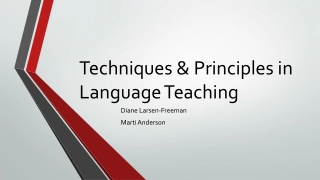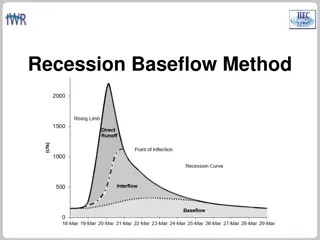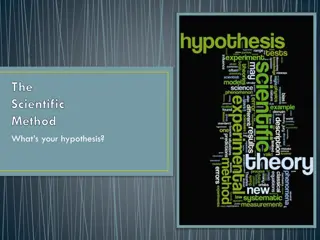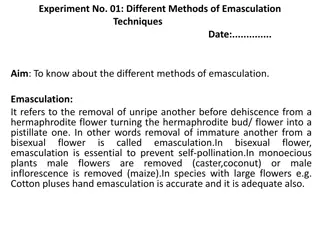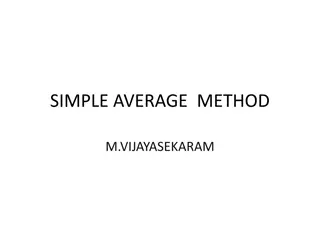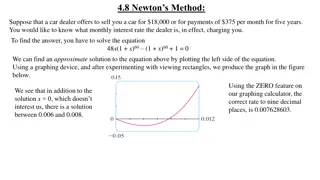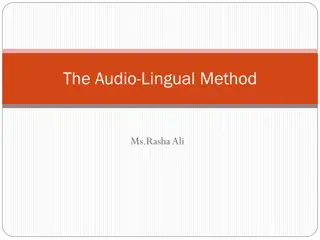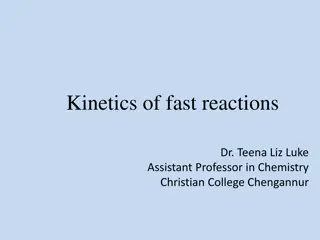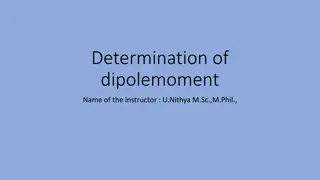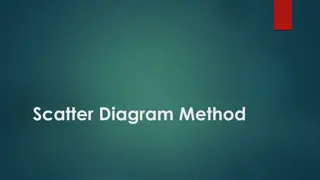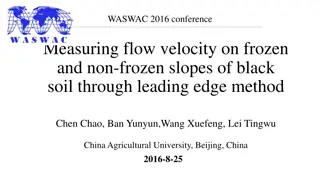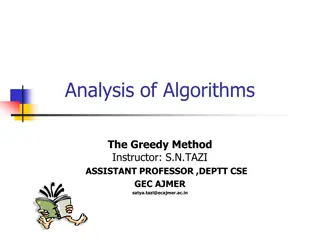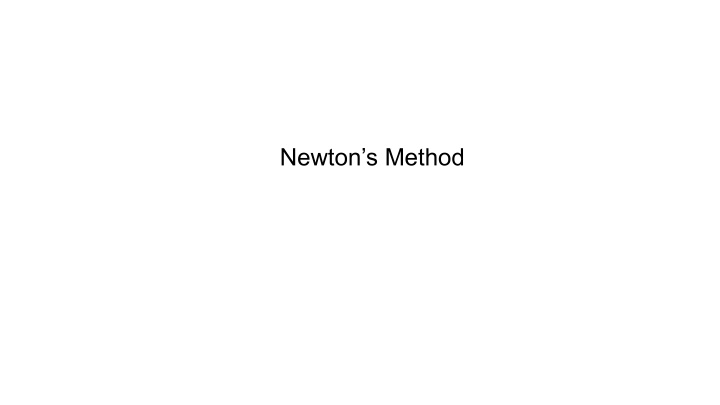
Applying Newton's Method for Finding Intersection Points
Learn how to utilize Newton's Method to find intersection points of exponential and polynomial functions through graphical and numerical approaches, with detailed instructions on formulation and implementation in MATLAB.
Download Presentation

Please find below an Image/Link to download the presentation.
The content on the website is provided AS IS for your information and personal use only. It may not be sold, licensed, or shared on other websites without obtaining consent from the author. If you encounter any issues during the download, it is possible that the publisher has removed the file from their server.
You are allowed to download the files provided on this website for personal or commercial use, subject to the condition that they are used lawfully. All files are the property of their respective owners.
The content on the website is provided AS IS for your information and personal use only. It may not be sold, licensed, or shared on other websites without obtaining consent from the author.
E N D
Presentation Transcript
How do we get this result? Use Taylor series expansion
Develop a MatLab code for Newtons method 1) What is the basic idea? 2) Put basic idea into a pseudocode 3) Translate pseudocode into MATLAB syntax
Basic idea behind a MATLAB function for Newtons Method function [r,fr]=newton(fh,dfh,x0) Inputs are function handles for f(x) and f (x) and initial guess of root How do we get an initial guess? Function handles are defined in the script that calls newton for a particular problem Inside the function calculate sequence x1, x2, xk, xk+1, stop when change xk-> xk+1 is small assign root to xk+1 calculate f(xk+1) to verify it is near zero
pseudocode for Newtons method: function [r,fr]=newton(fh,dfh,x0) steps = 0 x1 = x0 re = convergence requirement on fractional change on an iteration myrel = value of fractional change on the current iteration while (myrel>re) and (steps<maxsteps) increment steps save current estimate of root calculate next estimate of root myrel = absolute value of fractional change end while loop r = best estimate of root fr = fh(r) Put pseudocode into MATLAB syntex
Write scripts to use graphical and newton to find all the values of x where the graphs of ex and 3x2 intersect. How do you formulate this problem in terms of zeros of a function? How do you translate this formulation into a function handle that can be used in graphical?
Exponentials dominate polynomials; hence no intersections at very large values of x. Both ex and 3x2 are non-negative; hence intersections at negative values of x are possible. Start with a range of x values and refine it until you have good estimates for all possible points of intersection Write your script in the editor. Copy and paste into command window
myf=@(x) exp(x)-3*x.^2 graphical(myf,-5,5) 3 zeros but 2 near zero are not well resolved. Change range -1 to 4 and run it
Solution after refining range of x axis: approximate points of intersection of ex and 3x2 are -0.5, 1, and 3.75
Work in class Write a script to refine graphical estimates (-0.5, 1, and 3.75) by Newton s method. In addition to function handle for f(x), you will need a function handle for f (x). What is the derivative of f(x) = ex - 3x2? The function handle for graphical allowed vector input. Is this needed for newton?
At a minimum, your script need the following: function handle for f and df/dx call to newton that returns values for r and f(r) display of r and f(r) If your script works for one zero, it can be easily modified for other zeros. Modification can be done in the command window using the up arrow or you can write a script in the editor that returns all 3 refined zeros Write the script, run it, and let me know when you have results. Let me know if you have problems.
Script to refine multiple intersections of ex and 3x2by Newtons method copied to and run in the command window When you know the script runs successfully, you might want to save it. The script in the editor is called Untitled . If you want to keep it, use save as and rename.
Assignment 1 Estimate all the zeros of x3-x2-2x+1 graphically. Hand in copies of your graph with estimates marked Use Newton s method to improve estimates of zeros. Hand in a copy of command window that shows your script for using Newton s method and results.
Rate of convergence of Newtons method Use Taylor series to relate error in iteration n to error in iteration n+1
The convergence of Newtons method is usually quadratic. Error in the n+1 estimate is proportional to the square of error in nth estimate. Proportionality constant, f ( )/(2f (xn), depends on the initial guesses, which makes rate of convergence slightly dependent on the initial guess. Your next HW assignment will explore these differences. How do I change the newton function to get convergence data?
Modify Newton to get convergence data Absolute value of relative change in the estimate for the root, myrel, is our measure of convergence. With an initial value of 1 and rapid decrease to convergence requirement, 1x10-8, a linear plot will not show much. We could return values of myrel and make a semi-log plot. An alternative is return log10(myrel) and use plot. In either case, we must return an array whose length is unknown. MATLAB s dynamic array storage makes this easy.
Extended pseudocode for Newtons method function [r,fr,logre]=newton(fh,dfh,x0) Initialization steps = 0 x = x0 re = convergence requirement on fractional change myrel = current value of fractional change while (myrel>re) and (steps<maxsteps) increment steps save current estimate of root calculate next estimate of root myrel = absolute value of fractional change logre(steps) = log base10(myrel) end while loop r = best estimate of root fr = fh(r) end function
New version of Newtons method on class website to get convergence data to compare rates of convergence for different initial guesses Note alternative to inline Note suppressed output of logre
Write script to get convergence data for same root with different initial guesses How do we ensure convergence to the same root? Put convergence data for both guesses on the same set of axes How do we put 2 graphs on the same axes?
Graphs of ex and 3x2 have an intersection of near x=1 For initial guesses 0.5 and 1.5, Newton s method should converge to the zero near 1, since max and min separate these initial guesses from other zeros.
Pseudocode for script to compare the convergence Newton s method for different initial guesses define function handles for f(x) and f (x) Call newtonzeros with initial guess1= 0.5 Save r1 and convergence data as logre1 Call newtonzeros with initial guess2 = 1.5 Save r2 and convergence data as logre2 Display r1 and r2 to ensure convergence to same zero Call plot(logre1) Note: just one argument hold on Call plot(logre2) hold off When plot is called with 1 vector input, the array index is treated as the x coordinate.
Write a script for this pseudocode and run it. Adapt a script you have, if possible. define function handles for f(x) and f (x) Call newtonzeros with initial guess1= 0.5 Save r1 and convergence data as logre1 Call newtonzeros with initial guess2 = 1.5 Save r2 and convergence data as logre2 Display r1 and r2 to ensure convergence to same zero Call plot(logre1) Note: just one argument hold on Call plot(logre2) hold off
define function handles for f(x) and f (x) Call newtonzeros with initial guess1= 0.5 Save r1 and convergence data as logre1 Call newtonzeros with initial guess2 = 1.5 Save r2 and convergence data as logre2 Display r1 and r2 to ensure convergence to same zero Call plot(logre1) Note: just one argument hold on Call plot(logre2) hold off
Script to compare convergence of Newtons method What did I forget to do in this script?
Convergence of Newtons method with different initial guesses Note: only axes and curves returned from MatLab X0=0.5 X0=1.5 Y axis is log10(re) -5 corresponds to myrel = 10-5 Convergence to root of ex 3x2 in [0.5,1.5] with different x0 How do I know which label goes on what curve? X axis is number of iterations
The graphs of f(x) = ex - 3x2 near x=1, gives us a hint of which initial guess, 0.5 or 1.5, will converge fastest. Confirm this by values of logre1 and logre2 displayed in the workspace. Also check to see if r1 = r2.
For script we see that logre1 is output from call to newtonzeros with x0=0.5 Call with x0=1.5 creates shorter array, logre2. Elements of logre2 are more negative. If the data provided in the workspace is insufficient, display logre1 and logre2 in the command window.
All the information we need to see that convergence is faster with initial guess 1.5
Assignment 2: Download newtonzeros.m from class webpage. f(x) = ex - 3x2 has a zero in the interval [-1, 0] (see below). Use plot to compare the rates of convergence to the root with initial guesses 0 and -1. Verify that both initial guesses converge to the same zero. Hand in a copy of command window where Newton s method was called Hand in your plot with labels (by hand is OK) on axes and curves to show which curve goes with which initial guess.
You dont need a numerical method to find roots of the cubic y = x3 - x2 - 2x. Find roots by factoring. y = x(x2 - x - 2) = x(x+1)(x - 2). Factoring shows roots are -1, 0, and 2 What happens when you use Newton s method to find these root?
This code uses relative change in root as the convergence criterion. What happens when the root you are seeking is zero? Note alternative to inline Note suppressed output of logre
Note alternative to inline What happens when the root and the initial guess are zero? Note suppressed output of logre
y = x3-x2-2x roots -1, 0, 2 Root and initial guess are both zero. Run this script and see what happens. Root at zero: Initial guess = 0.75 Converges but myrel is increasing as iteration approaches divide by zero
y = x3-x2-2x roots -1, 0, 2 Root at zero: Initial guess = 0 Encounters divide by zero on the first iteration Root at zero: Initial guess = 0.75 Converges but myrel is increasing as iteration approaches divide by zero
Note alternative to inline What happens when the root is zero and initial guess is not? Note suppressed output of logre
y = x3-x2-2x roots -1, 0, 2 Root at zero: Initial guess = 0.75 Check the workspace to see if function handle for f(x) and f (x) are available. Run this script and see what happens Root at zero: Initial guess = 0 Encounters divide by zero on the first iteration
y = x3-x2-2x roots -1, 0, 2 y = x3-x2-2x roots -1, 0, 2 Root at zero: Initial guess = 0.75 Converges but myrel is increasing as iteration approaches divide by zero Root at zero: Initial guess = 0 Encounters divide by zero on the first iteration
Usually, the convergence of Newtons method is quadratic. Error in the n+1 estimate of the root is proportional to the square of the error in the nth estimate of the root. Since xk+1 = xk f(xk)/f (xk) involves f (x) in the denominator, convergence is not as fast when f (r)=0. Called a multiple root with multiplicity 2.
f(x) = cos(x) cos(3x) Ever other root is multiple, at least m=2. X
Convergence problems with Newtons method All can be avoided by a good initial guess

